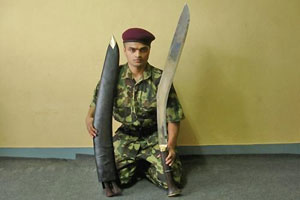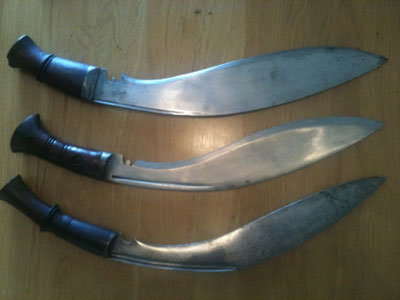Khukuri History
About Khukuri / Kukri:
The Khukuri is the national weapon and utility knife of the Nepalese people. It holds a unique place in Nepalese culture as more than just an exquisite example of local craftsmanship, or even a symbol of national pride, valor in battle, and personal bravery; although it is all of these things and more.
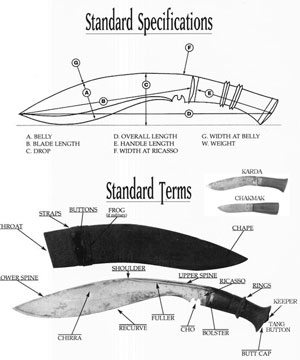

Of course, whenever the legacy of the legendary Gurkha soldiers is discussed, it is inseparable from the legacy of their traditional weapon, the Khukuri.
A Gurkha without his khukuri is unthinkable. Its unusual, medium-length, reverse-curved blade is far-famed as the traditional, iconic weapon of the Gurkha warriors who have wielded it in battle world-wide, for some 200 years.
It still serves as the national emblem of Nepal, and even denotes rank among the Nepalese security forces. But for a Nepalese, the khukuri also symbolizes more intangible qualities – strong character, honor, justice, human dignity, freedom. For us, there is no more powerful symbol of the strength and spirit of our nation and of the Nepalese people.
The khukuri is more to us than just a weapon: It serves an equal role in peacetime, as the traditional, all-purpose knife and working tool of the Nepalese people. In Nepal, khukuris are an indispensable feature in almost every household. In addition to its role as one of the most the most renowned fighting knives in the world- the wickedly curved knife of the Gurkhas of Nepal –it is most commonly employed as multi-use utility tool, rather like a machete. In this familiar role, it is used for the peaceful, daily tasks of chopping firewood, cutting meat and vegetables, skinning game, and opening cans of food.
It is also an important and integral part of our Nepalese culture – it represents our history, traditions, and spiritual beliefs. It serves as a symbol of wealth, social status, and prestige in Nepalese culture – It even has a clearly defined social role as an article of dress. For example, no well-dressed Nepalese groom would ever think of appearing at his wedding ceremony without his finest khukuri at his side.
Westerners may be surprised to learn that it is also an important spiritual talisman to us, as well. The shape of the blade represents the Hindu trinity – Brahma – the creator, Vishnu – the preserver, and Shiva, the destroyer who clears away the old to make way for the new.
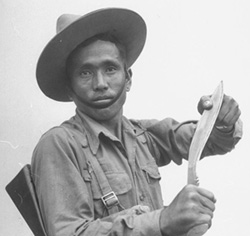

Even today, it plays an important spiritual role in the traditional rituals of the various different ethnic groups of Nepal: As a spiritual talisman, it is worshiped and paid respect and loyalty to, along with other useful iron and steel tools, during Dashain (the longest and most important festival in the Nepalese calendar), and at other times whenever any sacrifice is to be made. The traditional, ancient belief is that a khukuri kept in the home is said to bring good fortune and ward off evil spirits. Our ancient custom – still observed in traditional households – is that when we retire at night it is even placed under our pillows to prevent bad dreams, and dispel evil influences and thoughts.
So you can see how very much a part of us our Nepalese khukuri is. Its role in traditional Nepalese culture is both revered, and quite complex, and its cultural symbolism and importance to us is very deep indeed.
We, at Ex Gurkha Khukuri House, take great pride in helping to preserve this ancient tradition, and sharing it with the world.
History of Khukuri:
The Khukuri’s history actually predates the founding of the nation of Nepal. When the kingdom of Nepal was first created in the 16th Century, it was already the weapon of choice for the Gurkhas and their predecessors, the Nepali Sainik (warriors or soldiers).
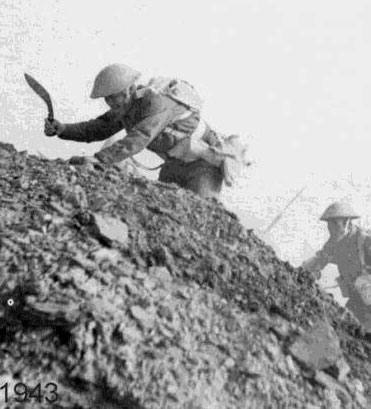

It is even possible that both stories are true: The Macedonian version of the kopis (the term used for the single-edged, reverse-curved sword used by Alexander’s cavalry) was strangely SHORTER than its Egyptian counterparts – interestingly enough, about the size of a khukuri. Whatever the circumstances were, though, they remain lost to history.
In any case, the present curved khukuri design as we know it today was born as an object of native craftsmanship in the hills of Nepal, in or around the 7th century BC – about 2500 years ago.
To put this into some sort of defining historical context, the Japanese katana is justifiably famed as the iconic sword of Japan’s fabled samurai warriors… But it is also true that when the great Japanese master craftsman, Amakune, made the first gracefully curved katana sword for the samurai, some 900 years ago, the art of crafting the khukuri was already more than a thousand years old.
The Nepalese khukuri has the unique distinction of being the only ancient battle weapon still in use in the field today – a distinction that is absolutely unique in the entire history of edged weaponry.
The khukuri first gained notoriety in the West for its ferocious effectiveness against the British troops who encountered it in the Anglo-Nepali War.The mutual respect each side gained for the other in that war forged the British-Gurkha alliance that continues to this day.
This emblematic weapon continued to serve the Gurkha warriors who wielded it through World War I, and World War II. During these conflicts, the knife gained high regard among allied and enemy troops alike, for its effectiveness and utility.
Because a Gurkha and his khukuri are inseparable, it was formally adopted as official military issue gear under British leadership – each Gurkha carries one as a part of his “kit,” in both parade and battle. No Gurkha would ever think of going into combat without one. In this way, the khukuri has also become a part of English history as well.
The English spelling of the word, Khukuri, has been rather “fluid” over the years, owing to the fact that the English characters used must be interpreted phonetically from the Nepalese language – So the word, “Khukuri” has also been written, khookree, khukri, khukuri, kukery, kukoori, and kukri. Early British dispatches and other accounts render it in three syllables – “koo-ker-ee” – It even achieved a certain degree of 19th Century British literary fame, when – in Braham Stoker’s classic tale of horror, Dracula, one of the English heroes, the stalwart Jonathan Harker, beheads the evil villain with a single sweep of his “great kukri.”
But however it is spelled, and whatever notoriety it has achieved elsewhere, it remains first and foremost the iconic, traditional battle knife of the Gurkhas.
